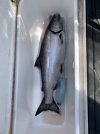With all due respects to the above poster...NO need for a treble hook with any kind of bait....my suspicion is that fishermen use treble hooks in the salt chuck out of habit more then as a piece of critical equipment.
I could have filled the back of a pick up truck with all the coho I released over the last two weeks (really) . I used straight spoons..no flasher...straight herring...no flasher .... straight anchovy...no flasher...yes, sometimes a dummy flasher attached to the downrigger ball, but more often then not, no flasher on the ball, especially when I was in a group of boats with everyone else using flashers...it was interesting to see how fast the hook ups happened in that circumstance, like the fish were just waiting for something different to come along
herring and anchovies were rigged on a tandem tie ....two single 3/0 hooks spaced approx. 8 cm apart. Some of the anchovies were fished in a Rhys Davis helmet but most were fished straight no chaser, the bend to make them spin produced by a toothpick or strategically placing the hooks to produce a bend
I wish I had lost more fish then I did using the tandem hook/NO treble set up
It sounds like you were in the right places when you fished the Sound....half of the salmon game is putting in the time at the right time. The time of the day is for the most part immaterial though yes, early AM sometimes can be better then high noon for springs....but what trumps early AM is the tide and what it's doing
If you were to fish two hours a day at both the high slack tide and the low slack tide, that would be more productive then fishing 4 hours a day in between the high and low slack tides
Regarding where to put your money for equipment....I carry two downriggers on my boat for the sole purpose of having a back-up In case one of them craps out. I will say with some conviction that you will catch more fish focusing your attention on one downrigger rather then trying to manage two.
Oh, you want to experiment at different depths? Well that’s what the clutch lever is for or the power-up button. You want to try different gear? Experiment with the different gear on the downrigger in front of you rather then splitting things up and scattering your attention between two downriggers
Put your money in a good sonar rather then a second downrigger. A good fishfinder will show you a picture like this.
Once you have that, it’s just putting the time in
By the way, the transducer I’m using to produce that screen shot I bought on eBay for $ 50
View attachment 69948
.

